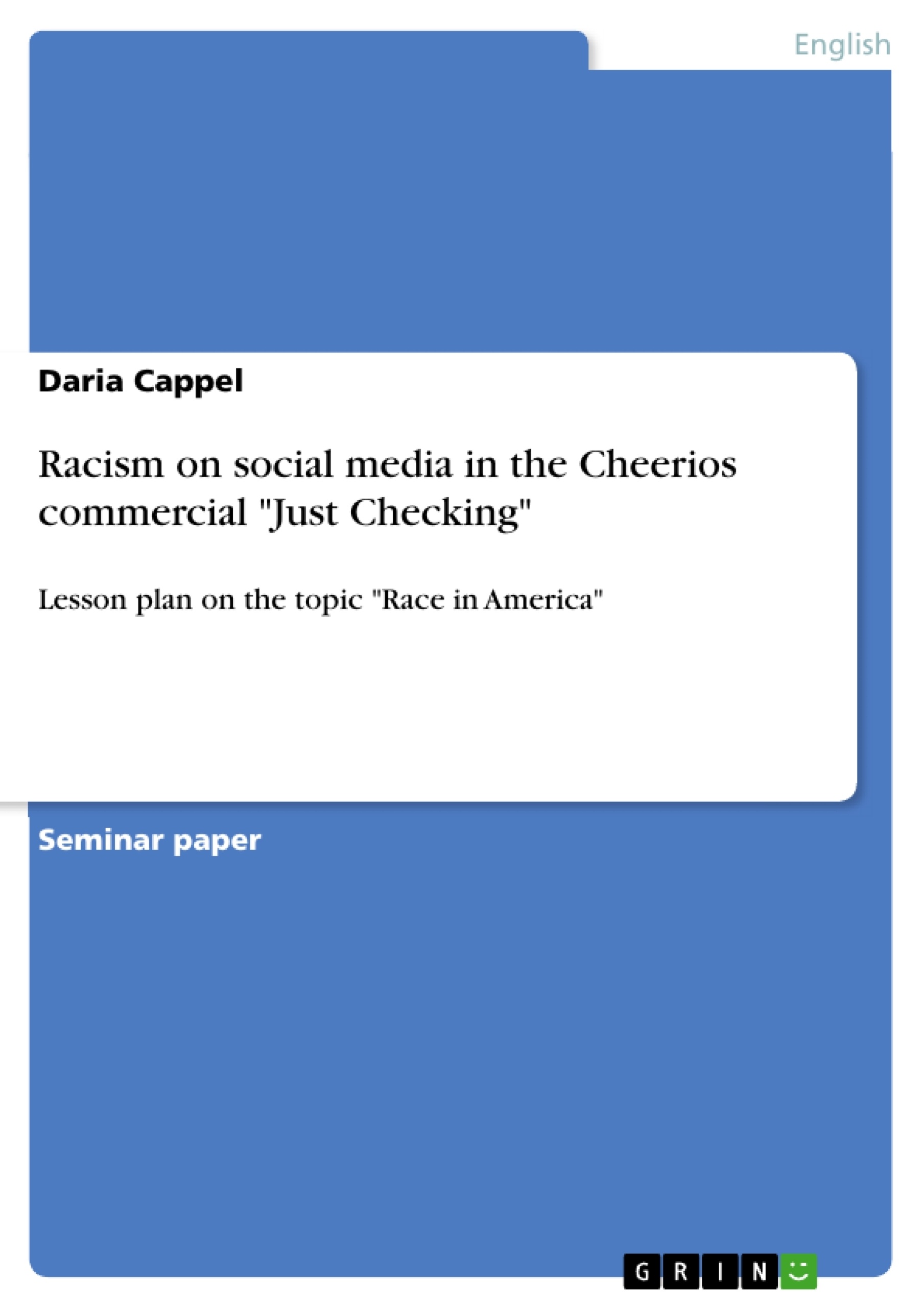In May 2013, Cheerios released a television commercial portraying an interracial family which consisted of a white mother, a black father and their biracial daughter. The commerical sparked a controversy over race and what an American family should look like. For its representation of an interracial family it received such a strong racist backlash on social media that the YouTube channel of the company had to be disabled.
The seminar paper aims to develop a lesson plan on the sensitive topic of racism and its impact on individuals, families and society, using the Cheerios commerical from 2013 and the debate it sparked on social media.
The author starts by depicting the commercial and its reactions following the release. In the next step, brief information on the history of interracial relationships and current data on interracial marriages in the US is given. Then, the author focuses on short films and commercials by presenting their definitions and arguments for their integration in the TEFL classroom. The paper concludes with a realization of the lesson and an explanation of the didactic decision.
Inhaltsverzeichnis (Table of Contents)
- Introduction
- The Commercial “Just Checking”
- Reactions
- Interracial Relationships in the US
- Theoretical Chapter
- Short Films
- Commercials
- Short Films and Commercials in the TEFL Classroom
- Realization of the Lesson
Zielsetzung und Themenschwerpunkte (Objectives and Key Themes)
This seminar paper aims to develop a lesson plan on the sensitive topic of racism and its impact on individuals, families, and society using the Cheerios commercial from 2013 and the debate it sparked on social media. It will delve into the commercial's content and reactions, provide information on the history of interracial relationships in the US, and explore the theoretical framework of using short films and commercials in TEFL classrooms.
- Racism and its impact on individuals, families, and society
- Interracial relationships in the US and their history
- The use of commercials and short films in the TEFL classroom
- The power of media representation and its influence on social discourse
- The role of social media in amplifying and shaping public opinion
Zusammenfassung der Kapitel (Chapter Summaries)
- Introduction: This chapter introduces the topic of racism and its relevance in contemporary society, citing examples of brands facing backlash for their portrayal of interracial families in commercials. It outlines the structure and objectives of the seminar paper, focusing on the Cheerios commercial as a case study.
- The Commercial “Just Checking”: This chapter delves into the content and context of the Cheerios commercial, describing its narrative and reception. It highlights the racist backlash the commercial received, particularly on social media, and Cheerios' response to the controversy. The chapter also explores the commercial's broader implications for American family dynamics.
- Reactions: This chapter focuses on the various reactions to the Cheerios commercial, including both negative and positive responses. It examines the racist comments, the company's decision to disable comments, and the counter-arguments and parodies created in response to the controversy. The chapter also highlights the public support for the commercial and its representation of an interracial family.
- Interracial Relationships in the US: This chapter provides historical context for interracial relationships in the US, focusing on the legal challenges they faced and the evolution of attitudes towards interracial marriage. It presents current census data on interracial and interethnic couples, highlighting the demographic trends and the increasing acceptance of interracial relationships in American society.
- Short Films: This chapter explores the history and contemporary relevance of short films. It delves into the evolution of short film formats and the technological advancements driving their resurgence. The chapter discusses the various types of short films and their potential for engaging audiences, highlighting their educational value and applicability in the TEFL classroom.
- Commercials: This chapter examines the role and impact of commercials, particularly in terms of their potential for influencing social perceptions and challenging societal norms. It explores the use of commercials as a teaching tool in the TEFL classroom, emphasizing their ability to stimulate critical thinking and discussions about cultural values and social issues.
- Short Films and Commercials in the TEFL Classroom: This chapter focuses on the theoretical framework for incorporating short films and commercials into the TEFL classroom. It highlights the pedagogical benefits of using these mediums for teaching English, particularly in terms of language acquisition, cultural awareness, and critical thinking skills.
Schlüsselwörter (Keywords)
This seminar paper focuses on the keywords: racism, interracial relationships, social media, commercials, short films, TEFL, lesson plan, cultural awareness, media representation, and critical thinking.
- Quote paper
- Daria Cappel (Author), 2018, Racism on social media in the Cheerios commercial "Just Checking", Munich, GRIN Verlag, https://www.grin.com/document/475291



